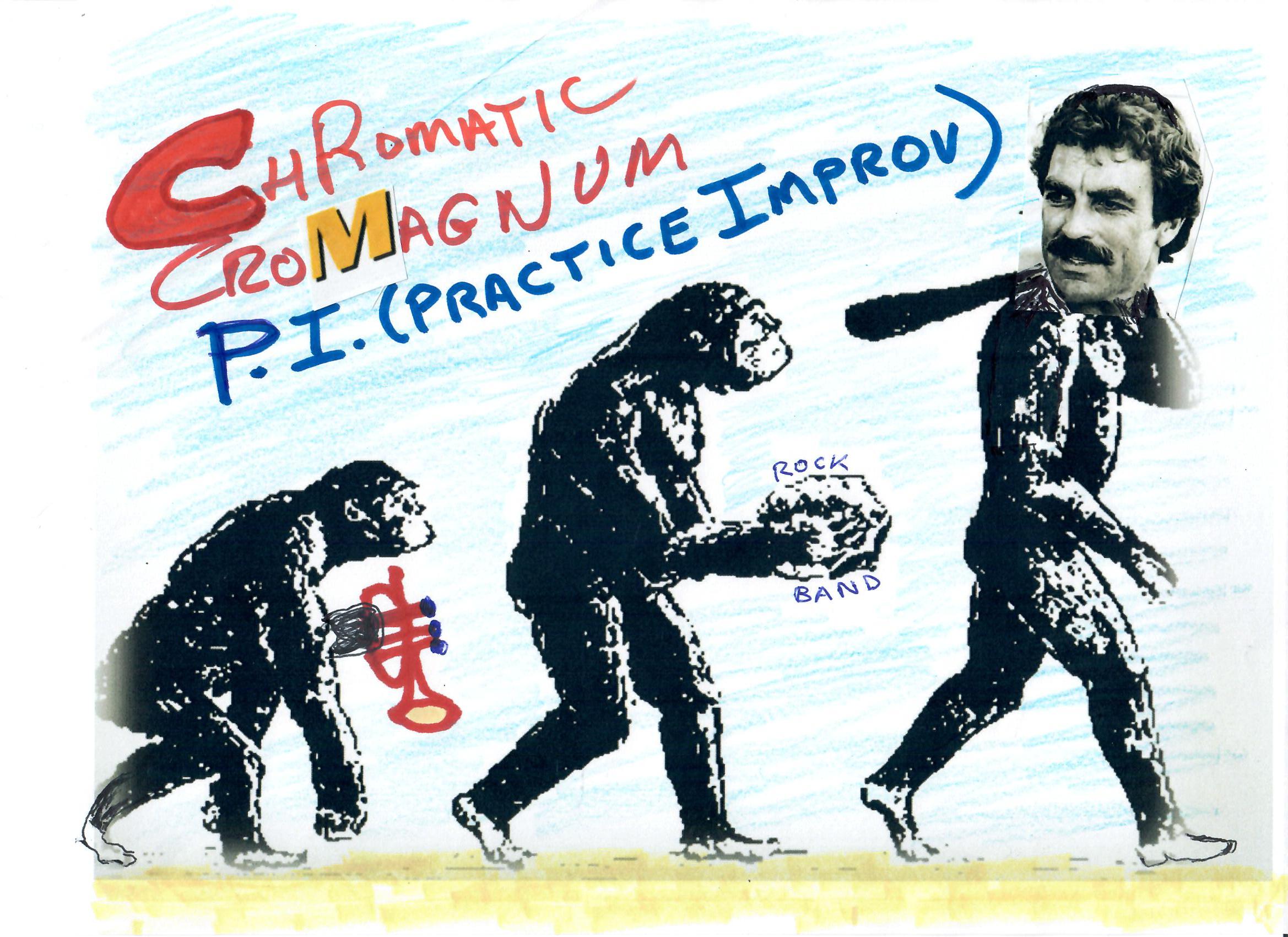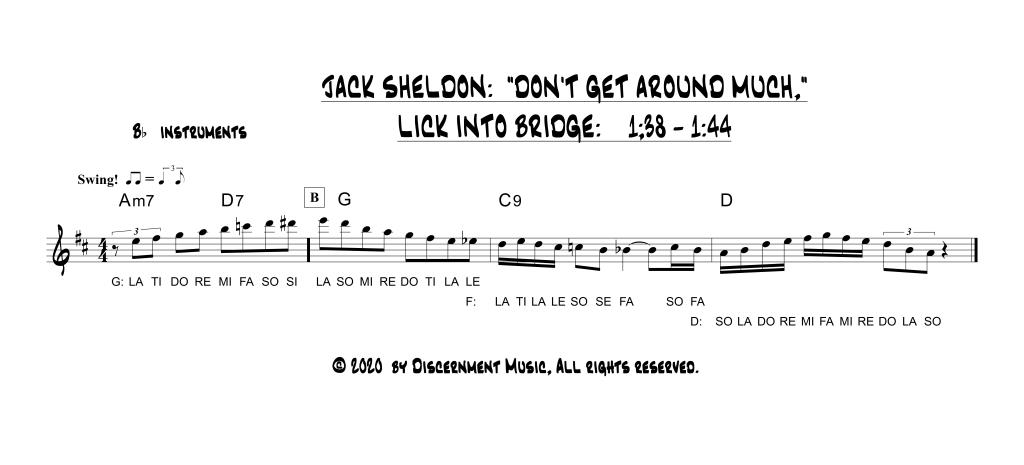 Pianist Dr. J. H. asked for a melodious exercise he could use to explore the harmonic minor scale in all 12 keys. The “harmonic minor scale” features the natural 6th degree FA along with the raised 7th degree. The raised 7th degree in a minor scale is the syllable known as “si” (pronounced “SEE”). It’s also referred to as “#SO” or “#7.” That scale is shown here:
Pianist Dr. J. H. asked for a melodious exercise he could use to explore the harmonic minor scale in all 12 keys. The “harmonic minor scale” features the natural 6th degree FA along with the raised 7th degree. The raised 7th degree in a minor scale is the syllable known as “si” (pronounced “SEE”). It’s also referred to as “#SO” or “#7.” That scale is shown here:
Category: chord
I Dig This One !
 Does improvising bring you joy? If you’re playing music you love, both you and your audience will be swept up in that transcendent joy. Here’s a topsy-turvy, tangled up, spaghetti-shaped, four-bar phrase that just tickles my spirit every time I play it. Hope you dig it too. Click here to watch the video.
Does improvising bring you joy? If you’re playing music you love, both you and your audience will be swept up in that transcendent joy. Here’s a topsy-turvy, tangled up, spaghetti-shaped, four-bar phrase that just tickles my spirit every time I play it. Hope you dig it too. Click here to watch the video.
Mode For Joe
 Saxophonist Maria is improvising over Joe Henderson’s classic jazz standard “Recorda-Me.” I asked her whether she would use the Dorian or Aeolian mode over the first 4 bars.
Saxophonist Maria is improvising over Joe Henderson’s classic jazz standard “Recorda-Me.” I asked her whether she would use the Dorian or Aeolian mode over the first 4 bars.
As shown below, the Aeolian is the mode rooted on LA, so it uses a lowered 6th degree. By contrast, the Dorian is rooted on RE, so it features a raised 6th degree.
Slippery Slope
For fans of Brazilian bossa nova jazz, here is a bright bossa composed and performed by tenor saxophonist Craig Buhler. In addition, if you have ever taken a terrible tumble, these ski slope stumble scenes will give you a chuckle and remind you that you’re not alone.
Below is a chart for B flat instruments you can view or download, in case you’d like to perform this song. (For charts in other keys or clefs, send me a comment listing your instrument, key, range, and preferred clef.) Continue reading “Slippery Slope”
Applying Moveable DO Syllables to Jazz Standards
Introduction
Alto saxophonist Pascal wrote requesting assistance with assigning movable DO syllables onto several jazz standards. Before addressing each of these tunes, let’s talk about the reason we use movable DO syllables.
As jazz musicians who play melodies by ear (without charts) and improvise over their changes, we are not concerned with theory for its own sake, as are academicians. Instead, our primary goals are:
Continue reading “Applying Moveable DO Syllables to Jazz Standards”
Fixed DO Versus Movable DO
“I was trained using ‘Fixed DO.’ In other words, if I am playing an E Major scale, I was taught to name the notes ‘MI, FA#, SO#, LA, TI, DO#, RE# MI’. Your book, “New Ears Resolution,” teaches me to think in terms of ‘Movable DO.’ What is your reason for preferring this method?”
Thank you for bringing this point up, Pascal. This is an extremely important question you have asked.
Have Fun with ii-V-I !
 If your set list includes numbers from “The Great American Song Book,” then you’re going to wrestle with the ii-V-I progression in a bunch of keys. Here’s a winsome ii-V-I phrase to help strengthen your chops, develop your ear, and arouse your creative vocabulary as a improviser. Click here to watch the video.
If your set list includes numbers from “The Great American Song Book,” then you’re going to wrestle with the ii-V-I progression in a bunch of keys. Here’s a winsome ii-V-I phrase to help strengthen your chops, develop your ear, and arouse your creative vocabulary as a improviser. Click here to watch the video.
Did the Key Change or What?
 The unpredictable flow of shifting key centers can easily throw uninitiated players off balance, especially when jamming on unfamiliar tunes. CLICK HERE TO WATCH THE VIDEO.
The unpredictable flow of shifting key centers can easily throw uninitiated players off balance, especially when jamming on unfamiliar tunes. CLICK HERE TO WATCH THE VIDEO.
I feel so much more like I do now than I did when I first got here.*
Jazz gigs seldom turn out exactly as we expect them to. Since jazz is, by definition, an improvised art, this should come as no surprise. It’s a maze which often thrills, sometimes shatters, and continually amazes us.
Let’s say, for example, that you arrive at the gig late, stressed, un-showered, and unready to perform. It’s at this point that a fan drops a hundred dollar bill in the tip jar, Herbie Hancock asks to sit in, and your first solo provokes a standing ovation. In your dreams, right?
The nature of jazz will, at times, lead to the unexpected, to exciting innovation, to surprise, to joyful discovery. …Occasionally, it leads nowhere. After all, life’s mazes do include blind alleys. Just the same, we “press on regardless” (as my father often preached on rainy hikes), in search of the perfect note, aye? Continue reading “I feel so much more like I do now than I did when I first got here.*”
Chromatic Cro-Magnum P.I. (Practice Improv)
 Ever feel totally drained after a big gig with no steam left to practice, like a malnourished Cro-Magnon? That’s how I felt this morning, after last night’s intense concert backing up my friend presenting 14 of his complex original compositions.
Ever feel totally drained after a big gig with no steam left to practice, like a malnourished Cro-Magnon? That’s how I felt this morning, after last night’s intense concert backing up my friend presenting 14 of his complex original compositions.
What’s a person to do? Well, “one foot in front of the other,” as the old saying goes. Just start blowing long tones; dig the sound of the horn, experience the feeling of wind on reed, fingers on pearls.
Here’s what emerged after an hour or so; a little chromatic meander that caught my imagination. As harmonized in this sketch, it forms a Dorian setting reminiscent of “So What,” “Little Sunflower,” “Jeanine,” or “Invitation.” It could also have been harmonized as a ii-V progression in C major modulating to D minor.

Click on “continue reading” below to see a chart and hear the recording in all 12 keys.
Continue reading “Chromatic Cro-Magnum P.I. (Practice Improv)”
Where’s One?
When a novice improviser strays too far from the beat, the band often quips, “Where’s One?”, meaning “Are you lost?”
As improvisers, we seek fresh, innovative approaches which still retain the coherence needed to keep listeners’ interest. Sonny Rollins famously used “motivic development” to simultaneously add unity and variety to his improvisations.
Here is a melodic phrase which is then repeated verbatim. What makes the second statement of this phrase sound different from the first?

Notice the “rhythmic offset”: the initial statement of the theme begins on beat 3 (we’re in 12/8), while the second statement begins on beat 12. Jazz players call this “playing on the other side of the beat.” If your band mates are sufficiently skilled to avoid getting lost, playing on the other side can be used to stunning effect.
Note also that the second statement of our melodic phrase – while melodically identical to the first – is accompanied by chords from a different key. We might refer to this as a “transposed harmonic setting.” The new harmonies give the melody a distinctly different sound, as if stage lighting on an actor had been changed from red to blue.
Practice Joy-Subconscious Symmetry
How’s your practice routine feeling lately? Are you practicing joy? If you practice joy, your audience will hear joy in your performance, and that lively winsomeness in your playing will win you way more fans than all the chops in the world.
Students ask what I mean by “practice joy.” Of course, it goes without saying that you need to develop your technique. But music is way more than just chops.
It may help to think of your practice session like a lavish banquet. …(we didn’t have many of those in 2020!) Think of it in 3 parts.
| Your banquet | Your practice session |
| 1. Introductions, greetings, catching up, small talk, hors d’oeuvres, drinks | 1. Your warm-up, settling in, loosening up, getting in the groove |
| 2. The main course | 2. Working intentionally through an idea or challenge |
| 3. Coffee, dessert, farewells, hugs or hand shakes | 3. Reward yourself with a fun little jam! |
Doesn’t that approach sound more doable, more inviting, more intriguing than staring forlornly at a closed horn case, wondering how to drum up energy to open that case and start playing boring scales?
Those 3 parts of your practice session remind me of Oliver Wendell Holmes’s comment about how a simplistic idea develops into a complex struggle but then resolves into a simple but elegant design.

So how about let’s design a practice routine so enthralling — so much fun — that you just can’t wait to pick up your axe and blow! As one typical example, here’s a practice session from a couple days back which was both productive and immensely enjoyable. Every day isn’t exactly like this. Sometimes the focus is on long tones, sometimes it’s reading through transcriptions, etc. But – on this particular late evening session – I followed Sonny Rollins’ advice. Sonny said, “just start playing the horn. Listen to the sound. Feel your breath and the keys of your axe. Play a blues. Play a tune. Play any old licks that come to mind.” Rollins called them “clichés,” but he didn’t mean that as an insult. They’re the bread and butter of learning. Don’t evaluate, don’t judge, just relate to your axe and enjoy how it sounds, how it makes you feel. After I blew for awhile, this lick just popped out.
I kind of liked it, so I kept repeating it. Maybe I tweaked it as I went along, I can’t remember. After getting it smooth in one key, I ran it down in all 12 keys. Then I wrote it down in my journal, knowing full well I’d forget it otherwise. After a day or two, I looked back at the transcription and discovered an inner logic — the thing that makes a phrase seem natural and organic – that I hadn’t noticed before. Up to that point, I’d just been blowing, without a sense of compositional coherence, or any of that theoretical stuff. But there it was, the musical logic, just waiting to be discovered…
Subconscious Symmetry
Below is a recording of me playing this phrase in all 12 keys along with a chart. After that, I discuss the logic hidden within this unusual phrase.
Listen and Learn
If he’d survived, trumpeter Jack Sheldon would have turned 89 on November 30th, 2020. For one who never studied his recordings, it’s fascinating to watch a live video of his quintet in concert. The five musicians play in perfect sync, like a well-oiled machine, and they swing like crazy. Jack’s vocal style is instantly recognizable, and his trumpet sparkles with fiery assertiveness, crisp inventiveness, and unhesitating self-assurance.
The lick leading into the bridge of Jack’s solo especially knocks me out. Here it is:

There’s a dynamic shape to that melodic line and an infectious rhythmic vitality which combine to offer a wildly exciting listening experience. Equally impressive is Jack’s ability to infer fascinating harmonic curve-balls creating two deceptive modulations before settling onto the home key, as portrayed on the chart above .
Here’s that lick in all 12 keys.
A complete chart is provided below, if you want to woodshed this unique lick.
My friend Bill – an excellent trombonist – voiced his frustration after attempting the licks on my blog at full speed. I reassured Bill that I certainly do not begin by playing any of these licks at its ultimate pace. Here is the original tempo over which I started wood-shedding.
It took me several hours to get the lick up to tempo. With each new pass, you ratchet the metronome up maybe 3, 4, or 5 clicks until you reach your goal, and the most difficult note sequences require extensive looping in order to achieve smooth, effortless execution.
Here is Jack’s full solo:
As stated above, the band swings like mad throughout this entire performance. Here’s a link, if you want to listen to the whole cut.
Click on “continue reading” below to see a chart of the lick in all 12 keys.
Continue reading “Listen and Learn”Band Bus Banter
On the band bus one day, a buddy criticized me for playing too many descending lines. According to him, “Descending is negative; Ascending lines are much more uplifting.” Oh….really?
Players constantly hear advice like that.
Another commentator assured me, “Your phrase cannot EVER begin on the downbeat; It’s got to be asymmetric.” OK, you win, asymmetric it is, smart guy! The customer’s always right, ay?
One nameless critic insisted, “In order to sound hip, your line has to include several non-harmonic tones.” Still another self-proclaimed “authority” touted the need to stuff many rhythmic devices into your phrase.
Finally, a laconic trombonist named Tex snoring in the back of the bus roused himself from slumber just long enough to drawl lazily,
“How a – bout we try ta swing, Stan?”
So what do you think?
What is it that makes a player sound fresh and innovative?
While listening to the masters and practicing, lines like this one seem to pop out of nowhere. Hit ► below and let me know if it works for you.
Click on “continue reading” below to see a chart in all 12 keys. Or download “New Ears Resolution” to supercharge your ear, so you can play licks like this one in all 12 keys without a chart.
Continue reading “Band Bus Banter”Half-Diminished? Minor 7, Flat 5? Aaargh !!
Click the link below to read the script of this video.
Continue reading “Half-Diminished? Minor 7, Flat 5? Aaargh !!”
Peaceful Assurance, Permanent Security.
Need a peaceful respite from the current chaos? Click Here.
How to Create, Name, and Use Chords to Evoke Emotion and Make Music Come to Life!
 In just 45 minutes, you can revolutionize your understanding of THE HARMONIC LANGUAGE. Learn how chords are created, what notes they contain, how they’re named, and how they’re used to evoke emotion and make music come to life. Quickly gain harmonic mastery and confidence which will set you apart as a composer or improviser.
In just 45 minutes, you can revolutionize your understanding of THE HARMONIC LANGUAGE. Learn how chords are created, what notes they contain, how they’re named, and how they’re used to evoke emotion and make music come to life. Quickly gain harmonic mastery and confidence which will set you apart as a composer or improviser.









